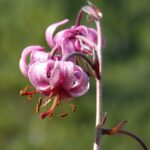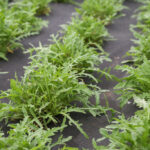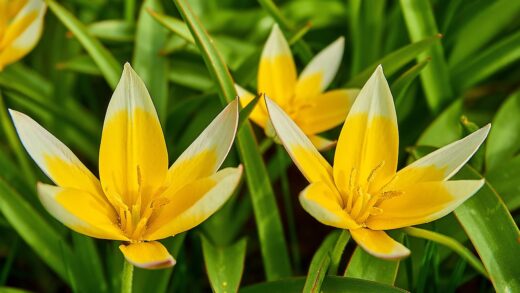The watering and fertilization of the Abyssinian gladiolus

Providing the correct balance of moisture and nutrients is fundamental to cultivating a thriving Abyssinian gladiolus. These elements are the lifeblood of the plant, directly impacting everything from the development of strong, healthy foliage to the production of its famously elegant and fragrant flowers. Watering practices must be carefully managed to avoid the twin perils of drought stress, which can lead to wilting and poor blooming, and overwatering, which is a primary cause of corm rot. Similarly, a well-considered fertilization strategy will supply the essential minerals needed for vigorous growth without encouraging excessive leaf production at the expense of flowers. Understanding the specific needs of Gladiolus murielae throughout its different growth stages—from the initial sprouting of the corm to the final fading of its blooms—is key. A proactive and observant approach to watering and feeding will ensure your plants have the resources they need to reach their full potential and grace your garden with a spectacular late-season display.
Watering needs during establishment
During the initial period after planting in the spring, the watering needs of the Abyssinian gladiolus are minimal. After the initial thorough watering immediately following planting, which settles the soil around the corms, it is best to withhold further water until the first green shoots appear. The corm itself contains enough moisture and energy to initiate sprouting. Keeping the soil too wet during this early stage, when there are no leaves to transpire moisture, can create anaerobic conditions that promote fungal diseases and may cause the corm to rot before it even has a chance to grow.
Once the pointed shoots have broken through the soil surface and begin to grow, you can start a more regular watering schedule. At this stage, the developing root system and the emerging foliage require a consistent supply of moisture to support healthy growth. The goal is to keep the soil evenly moist but never waterlogged. The best way to check if watering is needed is to feel the soil; if the top 2-3 centimeters are dry to the touch, it is time to water again. This encourages the roots to grow deeper in search of moisture, which helps to create a more resilient and drought-tolerant plant.
The frequency of watering during this establishment phase will depend heavily on your local climate and soil type. In sandy soils that drain quickly, you may need to water more often than in clay-based soils that retain moisture for longer. Similarly, during periods of hot, dry, and windy weather, water will evaporate from the soil more quickly, necessitating more frequent irrigation. Always water the plants at the base, directing the water to the soil rather than over the foliage. This helps to prevent the spread of foliar diseases and ensures the water gets directly to the root zone where it is needed most.
Deep, infrequent watering is far more beneficial than shallow, frequent sprinkling. A deep watering encourages the roots to penetrate further into the soil, establishing a strong and extensive root system. This robust foundation is crucial for supporting the tall flower spikes that will develop later in the season. A good, thorough soaking once or twice a week, depending on the weather, is generally sufficient to meet the plant’s needs during its vegetative growth phase. Consistent moisture during this period is critical for building the energy reserves required for a prolific flowering display.
More articles on this topic
Adjusting water for flowering and dormancy
As the Abyssinian gladiolus transitions from its vegetative growth phase to its flowering period in late summer, its water requirements reach their peak. The development of the tall flower spikes and the numerous buds places a high demand on the plant. Consistent and adequate moisture during this time is crucial for ensuring the flowers develop fully and the blooming period is prolonged. Allowing the soil to dry out completely when the plant is in bud or bloom can cause stress, leading to smaller flowers, bud drop, or a shortened flowering season.
Continue the practice of checking the soil moisture regularly and watering deeply whenever the top few centimeters become dry. During the peak of summer heat, you may find that you need to water every few days to maintain optimal soil moisture. Mulching around the base of the plants with a layer of organic material like straw, compost, or shredded bark can be highly beneficial. Mulch helps to conserve soil moisture by reducing evaporation, keeps the root zone cool, and also suppresses weed growth, reducing competition for water.
Once the flowering period has finished and the last of the blooms have faded, you should begin to gradually reduce the frequency of watering. The plant’s need for water decreases as it enters the final stage of its seasonal life cycle. The foliage will continue to photosynthesize for several weeks, sending energy down to the corm for storage, but its metabolic rate will slow down. Allowing the soil to become drier mimics the natural conditions of its native habitat and signals to the corm that it is time to prepare for dormancy.
In the autumn, as the foliage begins to yellow and die back, watering should be ceased almost entirely. Continuing to water heavily at this stage can be detrimental, as the cool, damp conditions can easily lead to corm rot, especially as the plant is no longer actively taking up much moisture. This drying-out period is an essential part of the hardening-off process, preparing the corm for being lifted and stored over the winter. A dry corm is a healthy corm when it comes to long-term storage.
More articles on this topic
The role of key nutrients
Understanding the role of the three primary macronutrients—nitrogen (N), phosphorus (P), and potassium (K)—is essential for developing an effective fertilization strategy for your Abyssinian gladiolus. Nitrogen is primarily responsible for vegetative growth, meaning it promotes the development of lush, green leaves. While important in the early stages, an excess of nitrogen, particularly later in the season, can lead to weak, floppy foliage and can inhibit flower production. The plant will put its energy into growing leaves at the expense of the blooms, which is not the desired outcome.
Phosphorus plays a vital role in root development and flower formation. It is crucial for the transfer of energy within the plant and is directly linked to the production of high-quality, abundant blooms. Providing an adequate supply of phosphorus is key to achieving a spectacular floral display. This is why fertilizers with a higher middle number (P) in their N-P-K ratio, such as bone meal or specially formulated bulb foods, are often recommended for flowering corms and bulbs.
Potassium, the third key nutrient, contributes to the overall health and vigor of the plant. It helps to regulate water uptake, strengthens cell walls, and increases the plant’s resistance to diseases and stress from heat or drought. A sufficient supply of potassium ensures that the plant is robust and resilient, capable of supporting its tall flower spikes and efficiently storing energy in the corm for the following season. It is a critical component for the long-term health and perennial nature of the plant.
In addition to these macronutrients, Abyssinian gladiolus also requires a range of micronutrients, such as calcium, magnesium, and iron, albeit in much smaller quantities. Most healthy garden soils rich in organic matter will contain sufficient levels of these micronutrients. Regular top-dressing with well-rotted compost or manure is an excellent way to replenish these essential elements naturally, improving soil structure and fertility at the same time. A holistic approach that focuses on building healthy soil is often the most effective long-term fertilization strategy.
A practical fertilization schedule
A simple yet effective fertilization plan for Abyssinian gladiolus begins at the time of planting. When preparing the soil in the spring, incorporate a source of phosphorus and potassium to support root growth and future blooms. A handful of bone meal or a balanced, slow-release granular fertilizer with an N-P-K ratio like 5-10-10 or 5-10-5 worked into the soil at the bottom of the planting hole is an excellent start. This provides a foundational nutrient supply that the plant can draw upon as it begins to grow.
Once the shoots have emerged and reached a height of about 15-20 centimeters, you can begin supplemental feeding. This is particularly important for plants grown in containers or in soil that is not inherently rich. A liquid fertilizer is a good option at this stage, as it is readily available to the plant’s roots. Choose a balanced liquid feed, such as one formulated for tomatoes or flowering plants, which will have a good ratio of phosphorus and potassium. Dilute the fertilizer according to the manufacturer’s instructions and apply it every three to four weeks.
Continue this feeding regimen through the peak growing season. The final application of liquid fertilizer should be made when the flower spikes begin to show color. Fertilizing beyond this point is not necessary and can even be counterproductive. You want the plant to begin focusing its energy on the flowers and then on replenishing the corm, rather than encouraging new, soft foliar growth late in the season. Ceasing fertilization at this time helps the plant to prepare for its natural transition into dormancy.
It is important to always water the soil before applying liquid fertilizer. Applying fertilizer to dry soil can scorch and damage the plant’s delicate roots. The soil should be moist to allow the nutrients to be distributed evenly and absorbed effectively by the root system. By following this simple schedule—a slow-release fertilizer at planting time and supplemental liquid feedings during active growth—you will provide your Abyssinian gladiolus with all the nutrients it needs to produce a truly magnificent and memorable display of flowers.
Organic vs. synthetic fertilizers
When choosing how to feed your Abyssinian gladiolus, you have the option of using either organic or synthetic fertilizers. Organic fertilizers are derived from natural sources, such as plant and animal matter. Examples include bone meal, fish emulsion, compost, and well-rotted manure. These materials release their nutrients slowly as they are broken down by microorganisms in the soil. This slow-release action provides a steady supply of nutrients over a longer period and greatly reduces the risk of over-fertilizing or burning the plant’s roots. Furthermore, organic matter improves soil structure, water retention, and the overall health of the soil ecosystem.
Synthetic fertilizers, on the other hand, are manufactured chemical products. They are designed to deliver specific, concentrated doses of nutrients in a form that is immediately available to the plant. This can be advantageous if a plant is showing signs of a specific nutrient deficiency and needs a quick boost. Synthetic fertilizers are available in various formulations, including granular, water-soluble, and liquid forms, offering precise control over the nutrient ratios. However, they do not contribute to the long-term health of the soil and, if used improperly, can lead to nutrient runoff, soil salinity buildup, and root burn.
For the long-term health of your garden and your Abyssinian gladiolus, a primarily organic approach is often recommended. Building healthy, fertile soil with regular additions of compost and other organic matter creates a resilient and balanced environment for your plants to thrive. Supplementing with a targeted organic fertilizer like bone meal at planting time provides the specific phosphorus boost that flowering corms appreciate. This approach nourishes both the plant and the soil it lives in, creating a sustainable and self-regulating system.
That being said, a balanced approach that incorporates both types of fertilizers can also be very effective. You might build your soil with organic matter as a foundation and then use a water-soluble synthetic fertilizer formulated for flowering plants as a supplemental feed during the peak growing season. This can provide the best of both worlds: excellent long-term soil health from the organic matter and a targeted, fast-acting nutritional boost during the critical period of bud formation and flowering. The key is to use synthetic products judiciously and always follow the application rates recommended on the packaging.
📷 Flickr / Szerző: Stefano / Licence: CC BY-NC-SA 2.0



















